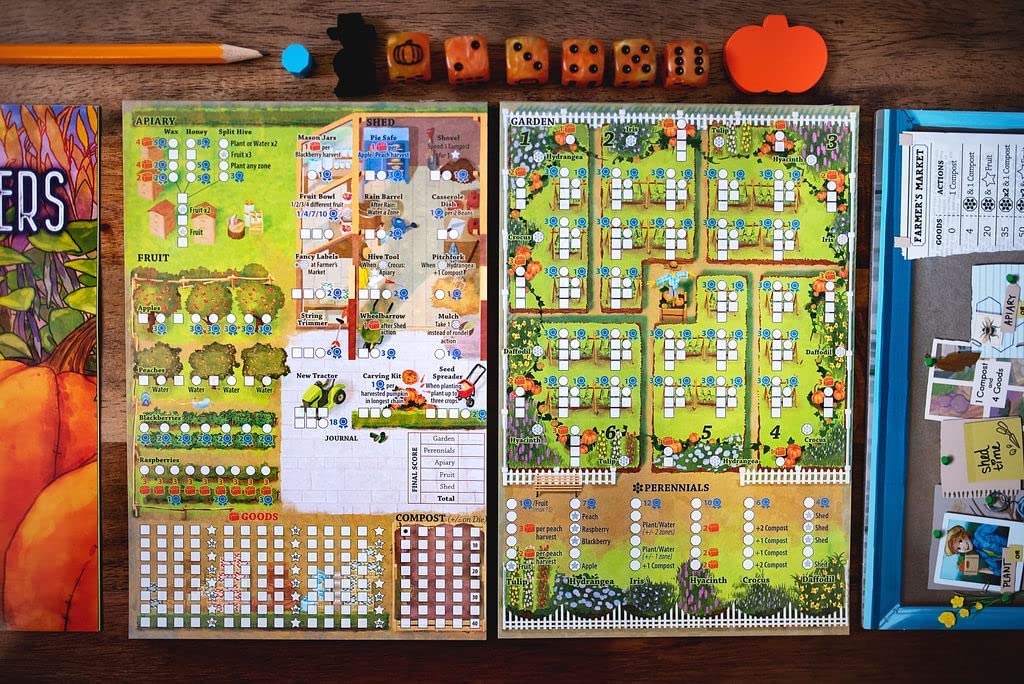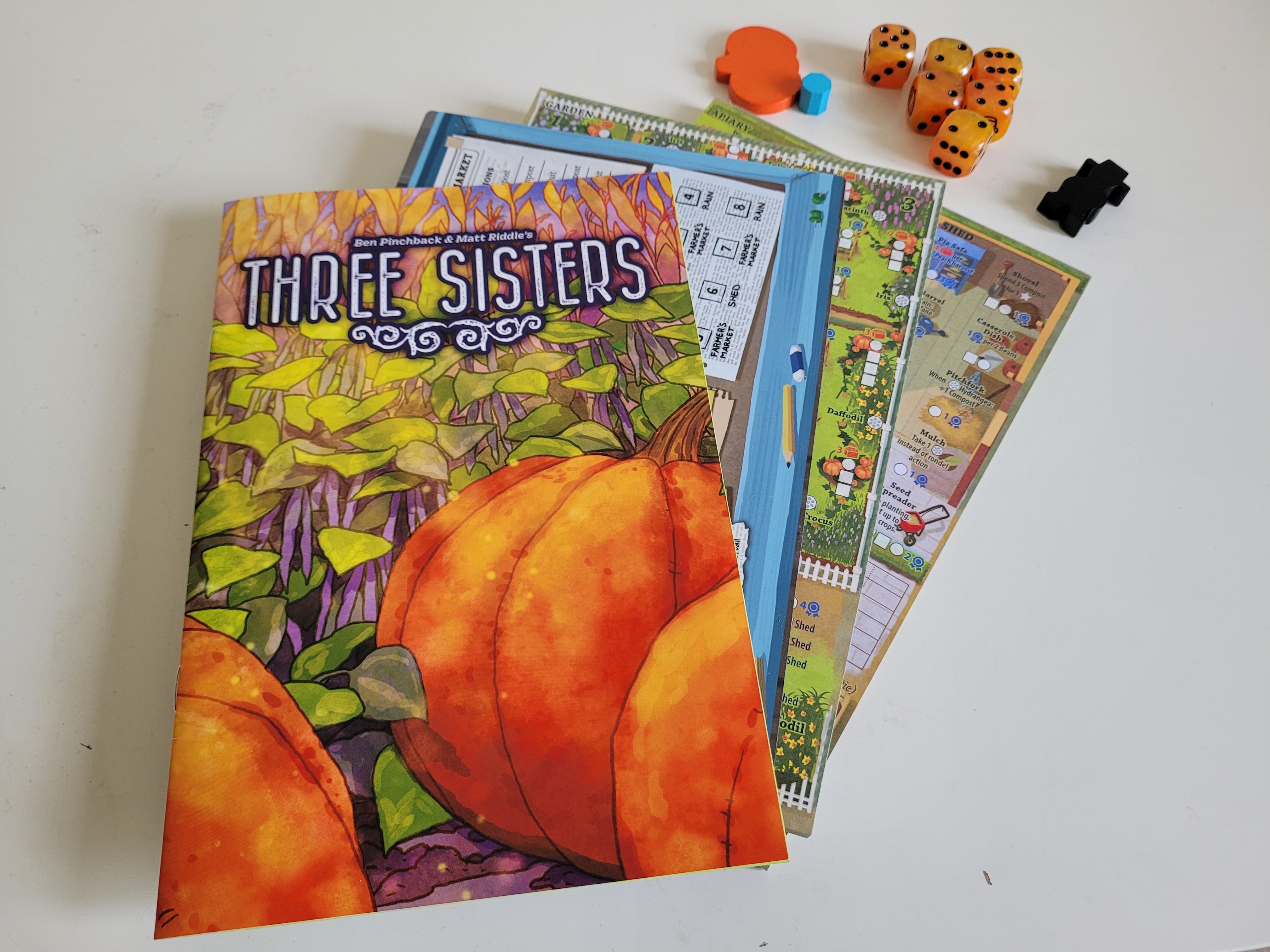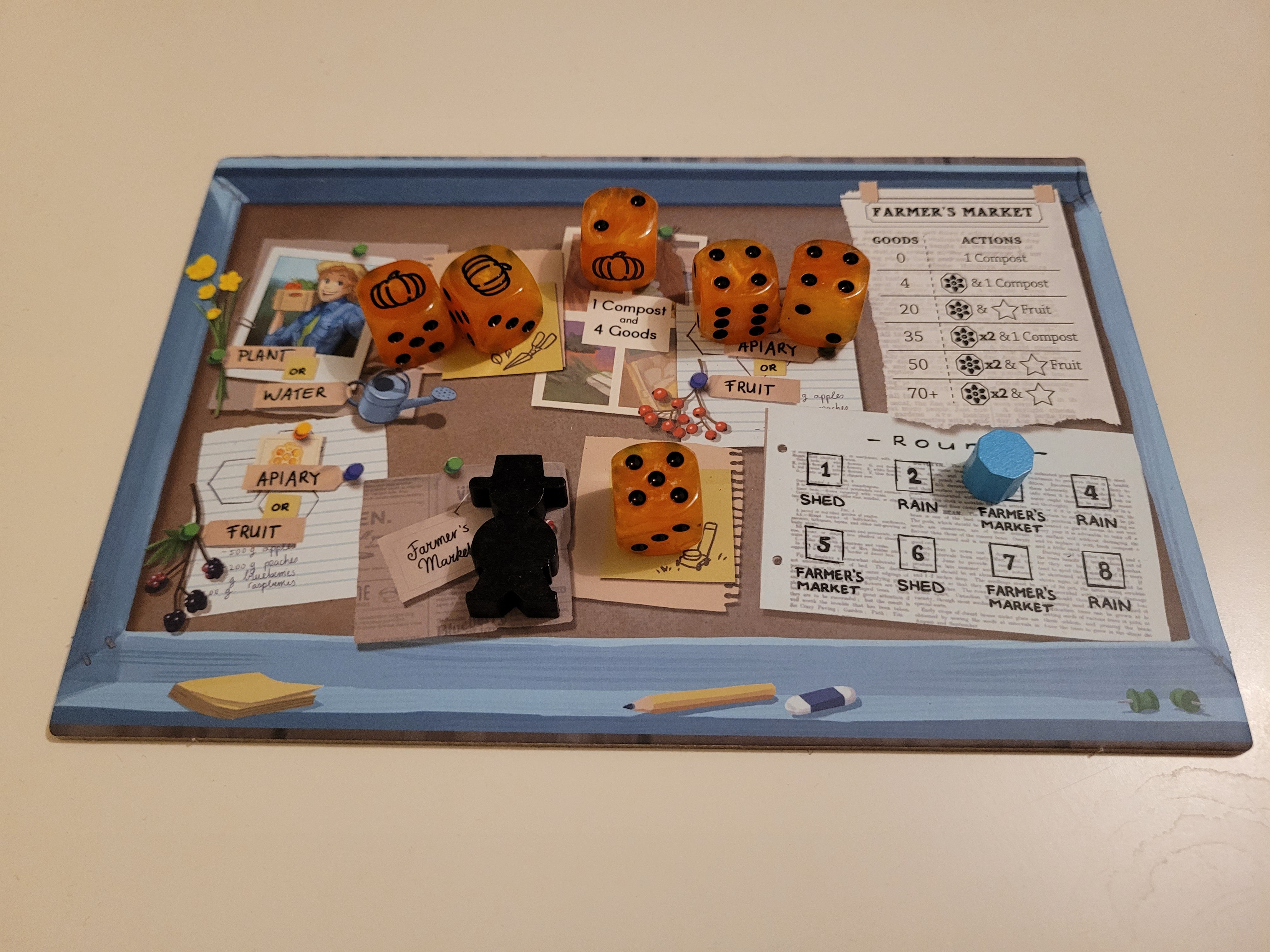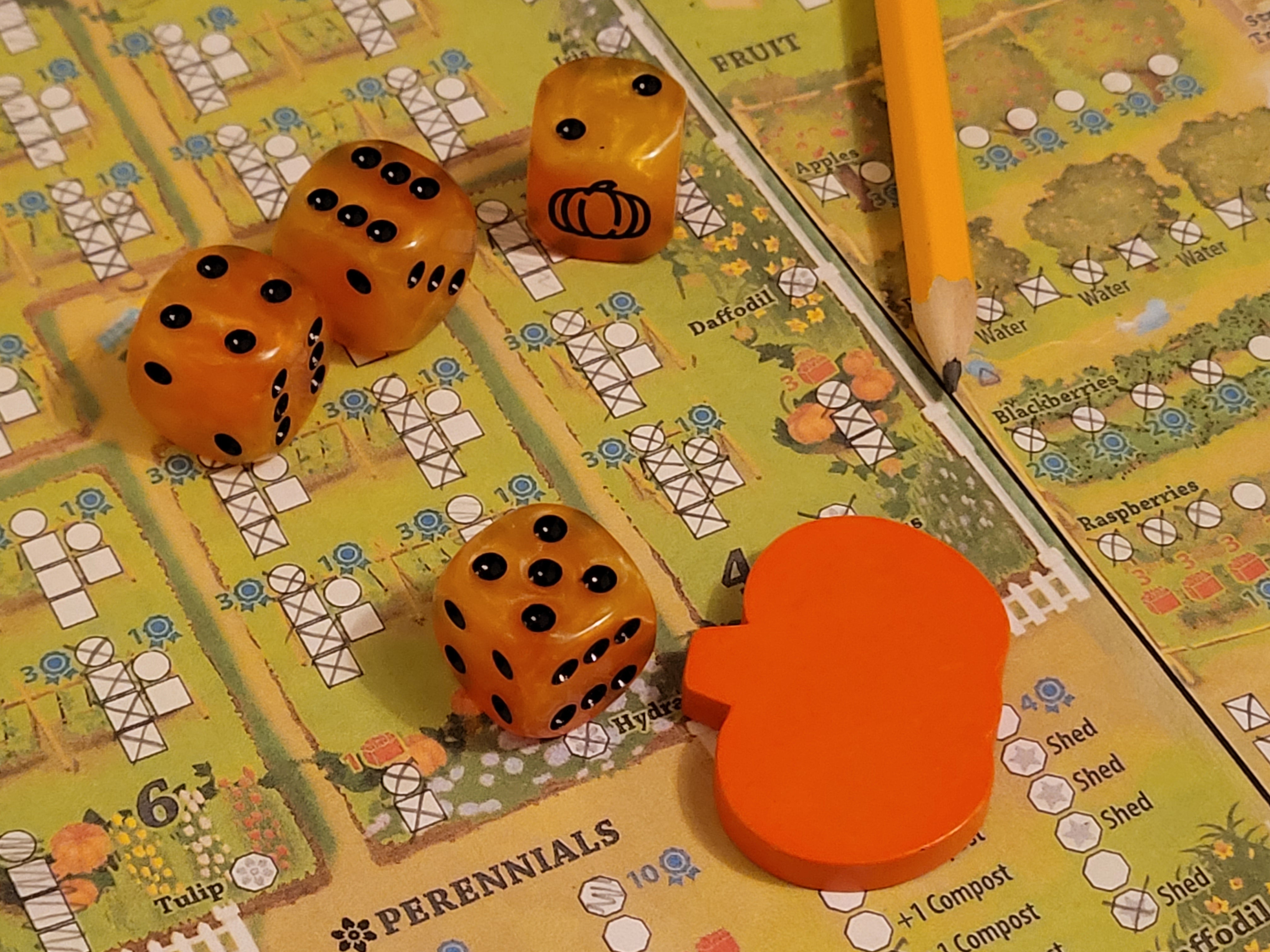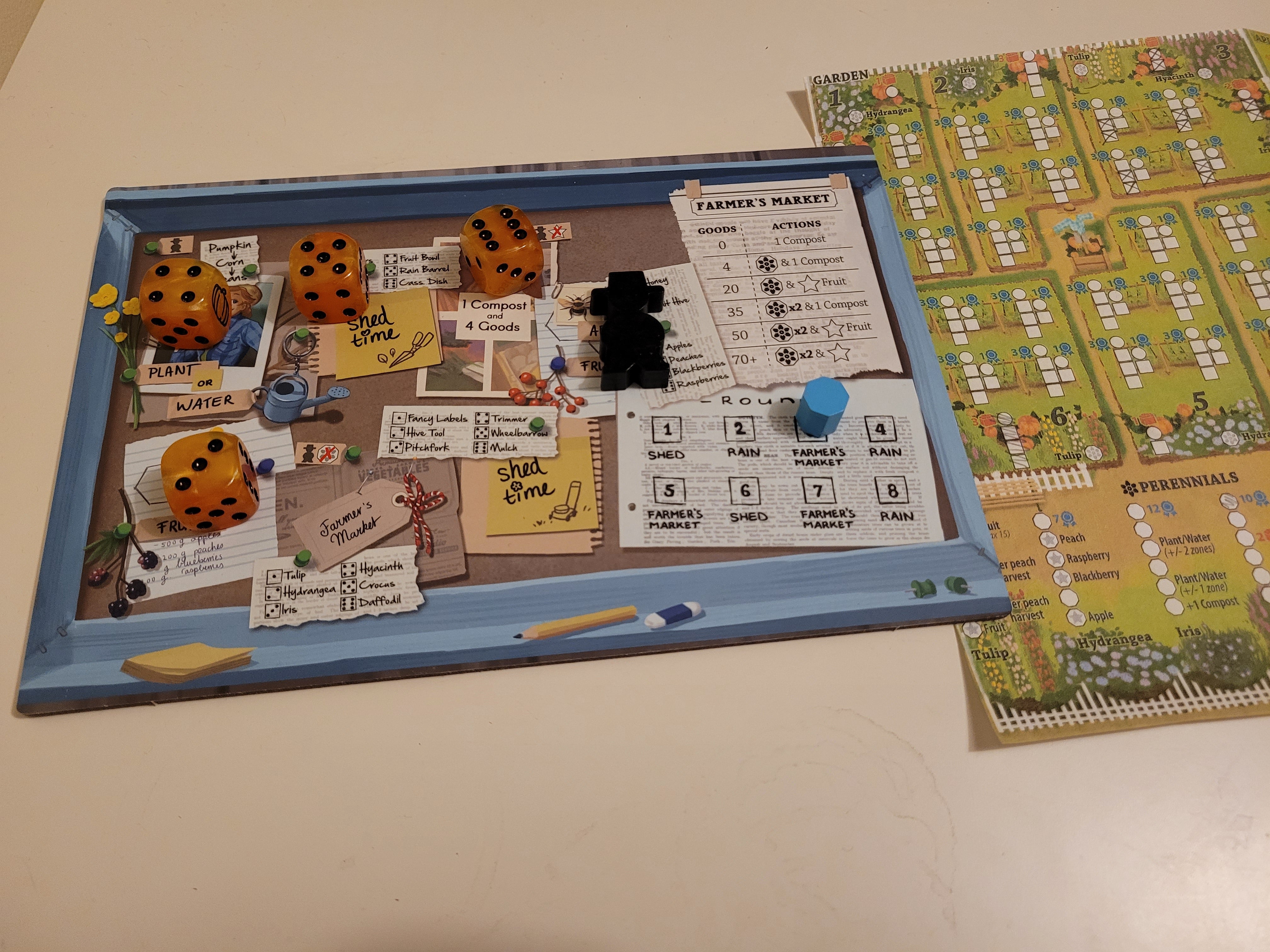From the large pumpkins on the box and the connection between the name and a witch’s coven, you could be forgiven for thinking that Three Sisters (see it on Amazon) is a game about Halloween. In fact, it’s a game about farming: Three Sisters is a name given to a complimentary planting method used in Mesoamerica since antiquity. The pumpkin plant covers the ground, preventing weeds, and it’s planted with corn and beans, the latter of which uses the former as a trellis.
This unlikely theme is the inspiration for a roll-and-write game, where players roll and pick dice, filling in parts of their scoresheet. Yahtzee is the best-known game in this genre thanks to its mass-market production, but Three Sisters is about as far from Yahtzee as you can get.
What’s in the Box
Like most roll-and-write games, the bulk of the box in Three Sisters is taken up with score sheets you can rip off and write on to play. Unlike most such games, it has two separate sheets. One tracks your garden of flowers and vegetables. The other has your shed, your beehives, a long track for the goods you’ll produce, and a space to make notes. This latter addition may strike you as odd, but you’ll soon find out why it’s helpful.
The art is fine, all the greens and oranges you’d expect in a growing garden. The remaining components consist of some neat orange custom dice with pumpkin icons where the “1” should be and some wooden components. There’s a pumpkin for the first player, a cylinder to track the round, and a black wooden farmer token to follow the current space on the rondel.
Rules and How it Plays
There are eight rounds in a game of Three Sisters and each starts by rolling a pool of dice based on the number of players. You sort dice into groups of the same value and then place each group on a space on the board, following a cycle called a rondel. Each space on the rondel corresponds to an action you can take in-game: the dice roll thus limits what actions are available.
Players then take turns to choose a dice and take the corresponding action. First, though, they get to tend their garden. At the top of one of the score sheets, there are six zones of boxes for pumpkins, which give you goods to sell at the market, and corn and beans, which give you points. In the zone matching the die you chose you can either make two new plants or water, which allows all the existing plants to grow a box.
Other actions include growing one of several fruits, tending to your hive of bees, getting a box of goods to sell, the market itself and the shed. This latter lets you cross off boxes from a wide range of tools that give you special powers. They run from mason jars, which let you sell fruit harvests as an additional good, to a tractor which does nothing but scores you a whopping eighteen points if you can fill in all its boxes.
If you grow two adjacent pumpkins to full height you can also take a perennial action and, like fruit, there’s a range of these. Hyacinths give you bonus goods, for example, while hydrangeas give you bonus fruit-growing actions. You also get perennial actions for selling goods at the market, and the more goods you have the more such actions you’ll gain. Filling up your goods track also gets you free actions which can be spent on fruit, perennials or the hive as you so choose.
As you might gather, Three Sisters is pretty complex as roll and write games go, although that’s still simpler than a lot of its bigger brothers. But there’s another reason we’ve labored over the rules rather than telling you upfront how it plays, and that’s because you have to have an understanding of how all the game elements intersect before you can understand what makes it special.
Let’s say, in your turn, you choose to take a free goods action. First, you get to water, and that will grow some pumpkins to increase your goods track. This nets you a free action, which you spend on some raspberries to increase your goods track even more. Combined with your pumpkin harvest, that gets you a second bonus action, and you haven’t even filled in your free goods yet! Even with two unresolved actions in the bank, that grown pumpkin brackets a perennial so you can take that action too: and resolving those three actions could net you even more actions.
This is why there’s a notes space on the scoresheet: so you can track unresolved actions while you work out your turn. These huge chains of combos are what Three Sisters is all about, and they’re great. Taxing to work through and work out to maximise their potential, satisfying to execute and often banking big swings of points into the bargain. Few other roll and write games go down this route, and none quite as well as here.
Because players take individual dice, rather than all working off the same roll as in most games of this genre, turns can be a little slow. But people can be left to sort out their combo chains by themselves other players take their actions. It’s easy to make mistakes, though, and accidentally miss an action or do something that’s not strictly allowed. It also makes for a very heads-down kind of game where you’re concentrating on your own scoresheet and not caring what other players are doing. The only sound is the scratching of pencils and the occasional ooh and aah over a particularly big scoring cascade.
The complexity of the scoresheet does lend itself to trying multiple strategies, though. While grabbing a couple of shed items early looks like a no-brainer decision, after that you can prosper in all sorts of routes. Your garden, your apiary, your fruit orchard, market sales and your perennial borders are all big sources of points and all support each other in different ways. So while your choices may be shaped early by the fate of the dice there are lots of different strategic routes to explore as the game progresses.
Where to Buy
- About
- Action
- ADDITION
- Additional
- All
- Another
- Art
- available
- Bank
- Banking
- Bees
- before
- Black
- board
- bonus
- Box
- choices
- complexity
- components
- corn
- could
- Couple
- covers
- Current
- different
- down
- Early
- explore
- farming
- fine
- First
- follow
- Free
- full
- game
- Games
- good
- goods
- great
- Grid
- Group
- Grow
- Growing
- harvest
- here
- Hive
- How
- HTTPS
- huge
- in-game
- Increase
- Inspiration
- IT
- large
- Long
- MAKES
- Market
- May
- more
- Neat
- net
- Orchard
- Other
- People
- plants
- play
- player
- players
- pool
- potential
- preventing
- Produce
- Production
- progresses
- range
- review
- Roll
- rounds
- Route
- rules
- Run
- sales
- sell
- SIX
- So
- Soon
- sources
- Space
- spend
- Strategic
- Strategies
- support
- The
- the dice
- theme
- Thinking
- Through
- token
- tools
- top
- track
- value
- Water
- What
- Work
- work out
- working
